Working backwards
Recently, I've been doing some work for the forthcoming Harmony cart. In case you've missed it, the Harmony is a programmable cartridge for the 2600, which you can use as a multi-cart for playing nearly every 2600 game ever made, or for developing homebrews and testing them on real hardware.
The genesis of the project was in trying to come up with a way to produce homebrew cartridges in a more efficient manner, rather than Albert having to hand-solder and assemble every single circuit board, one at a time. The end result uses an ARM processor to handle all of the various bankswitching modes, extra RAM schemes, the DPC (Pitfall II) chip, and even SuperCharger circuitry that 2600 games have used over the years. This is possible because all of that extra stuff was handled externally from the 2600, so by finding a processor that could be programmed to reproduce those functions and load the necessary game ROMs, the 2600 just sees exactly what it would if the original games were plugged into it.
Now the original Harmony project is actually being referred to as Melody, rather than Harmony, because the Harmony cart has developed into a programmable multi-cart, which features a USB port (for firmware updates) and an SD card slot for loading games. I've been beta-testing it, and it works slick! I've had a Krokodile Cart for a few years now, and the Harmony is basically a more modern version of it. The cost of components has come down, their functionality has gone up, and so the Harmony is not only cheaper, but is easier to use (the SD card is sweet, and no power supply is required), and has broader compatibility. (Incidentally, the name Harmony comes from the ARM processor, and the multi-cart aspect of it; whereas Melody is meant as a single-game, mass-produced, low cost means for producing homebrew cartridges.)
Anyway, after months of development, the Harmony was sold as a pre-production version the other week at the Portland Retro Gaming Expo. But first, it needed a logo. That's where I came in.
First, I was asked to come up with a small logo for the on-screen menu. Initially, it just said "Harmony" in plain text:
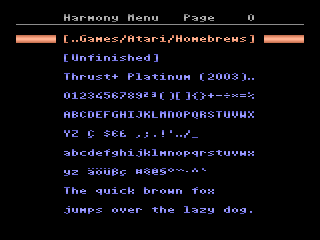
I didn't have much space to work with, but kicked around about a half-dozen ideas, including:

And:
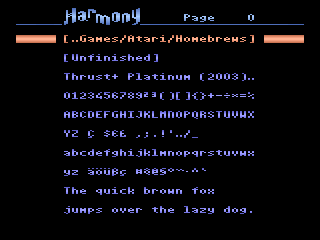
Which became the one that we ended up going with.
My idea behind the design was to mimic the flow of notes moving up and down a musical staff, and then incorporate a musical note into the "H" (hardly a new idea, by the way ![]() ). And while the Harmony cart isn't exclusively geared to music, it really doesn't make much sense to ignore the name's musical connotations. (Incidentally, there is no musical staff onscreen because we tried it, and it just became too cluttered.)
). And while the Harmony cart isn't exclusively geared to music, it really doesn't make much sense to ignore the name's musical connotations. (Incidentally, there is no musical staff onscreen because we tried it, and it just became too cluttered.)
Then, we needed a label.
Fred (batari) had taken a really nice photo of the Harmony board, so that became the background:

The trick then, was how to translate the onscreen logo to something suitable for the cartridge? Usually I work the other way - starting with a high-resolution logo, then reducing it to work on the 2600.
First, I just tried tracing the onscreen logo and smoothing it out in Illustrator...
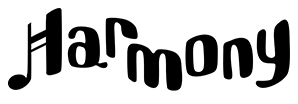
Uh... no. Too sloppy.
So then I decided to try modifying a font, to see if I could mimic the onscreen "font" I'd drawn...
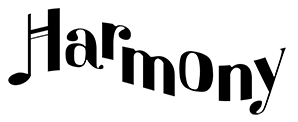
Ick. It took too much hacking to get the letterforms where I thought they needed to be. Clearly, a different approach was in order.
So I decided to just design the logo the way I normally would - make it look good at full resolution first, and worry about the onscreen version later.
I started out with a different font that I felt would lend itself to the look I wanted without having to do extensive hacking to it. In this case, Bernard MT Condensed:

I also grabbed a note from the Opus font:

Then, I incorporated that into the "H", and chopped off most of the serifs from the font:

After that, I offset the letters as if they were moving up and down a musical staff, and modified the "y" to wrap around the "n":
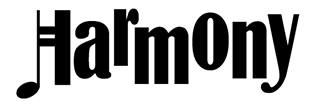
And finally, I used Illustrator's "warp" function to make the letters flow together, and at Thomas' suggestion, added a slur under "arm" to emphasize the name's origin:
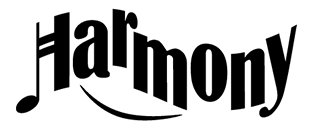
Several passes and revisions at the pre-production label followed, until we arrived at:

Which is, in all likelihood, going to be very similar to the final production version. There currently isn't an end label, since the end of the cart is mostly taken up with the SD card slot and USB port. But you never know... ![]()
After all this, I had to go back and redesign the onscreen logo to better match the cart label. A few more revisions followed, and in the end, it had to be about half-height, since there just wasn't room in the menu for a proportionally correct logo. But it's essentially the same logo, and I'm satisfied with it (and kudos to Thomas for coming up with the extra bytes necessary to even fit it on there):
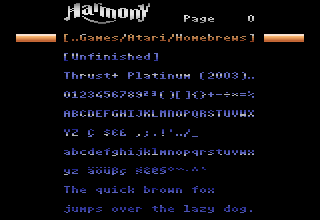
And an actual screenshot of the menu, from Stella, with color:

So keep your eyes peeled for the Harmony cart. I still have a manual to design (once the text gets finalized), and there's some more testing to do. But it seems to be entering the final stretch now, and I think it's going to be a big hit. Even more though, I'm excited about the possibilities the Melody cart may open up for homebrewing with extra RAM, ROM, and other goodies. ![]()


10 Comments
Recommended Comments